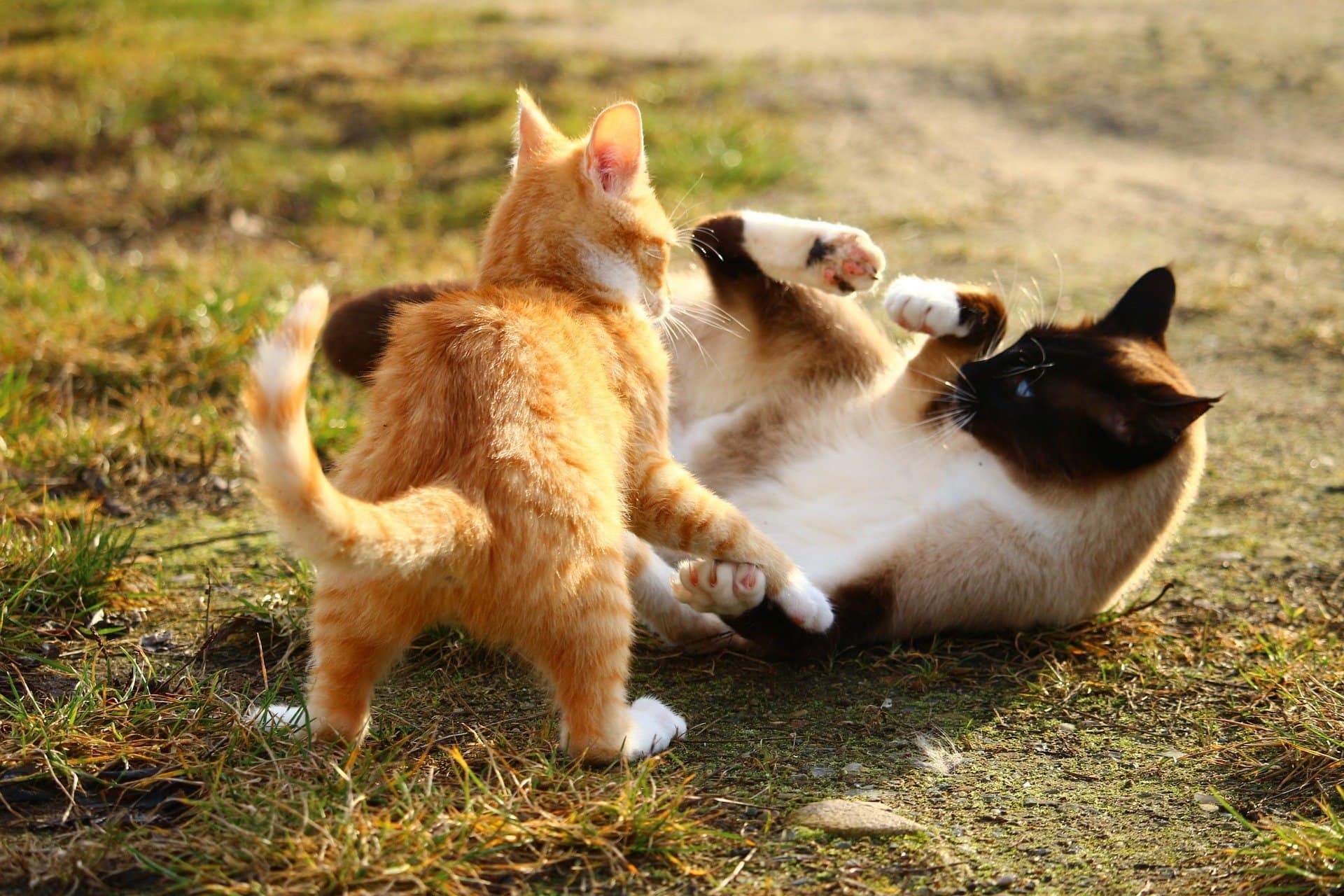Every cat owner enjoys playing with their little paw friends or watches them play together, but sometimes, our cats might seem too aggressive when playing, and we cannot differentiate whether they are playing or fighting. When we are playing with our cats, sometimes they tend to scratch our hands or even bite it. Most pet parents take it an aggressive playfulness, while other pet parents consider it as their cats being aggressive with them or showing negative behavior.
We can also notice some strange behavior when cats are playing with each other, sometimes they are adorable and cuddly. In contrast, other times, they could show signs of aggressive behavior towards one another, such as pushing each other away or biting each other on the ears.
Therefore, how can we know if our cat has a playful or aggressive behavior? Is it normal for your cat to bite you or to bite other cats when playing? Moreover, how to tell if cats are playing or fighting?
NOTE: We want to inform our blog readers that before we publish any article the team “Proudcatowners” Do deep research based on experience and knowledge about cat’s and everything related to them, to guarantees reliable and precise information, satisfy the readers is our first priority
How to tell if cats are playing or fighting?
This is a tricky case for many cat parents, most of them get confused, and they cannot tell if their cats are playing or fighting. When it comes to our feline friends, playing style changes as the cat ages. However, it is most commonly accompanied by aggressive-like behavior, whether with adult cats or kittens.
If you have adult cats, you should expect to see some intense playing happening between them, cats do not play nice, nor gentle. If you have more than one cat in your household, and they are not used to each other, they usually would not engage in playtime with one another since they are not familiar with each other.
Many cats can have hostile encounters. Therefore, if your cats that usually view each other as opponents, and do not have the gentlest relationship, start rumbling around, it is probably not playtime. They are getting into a more severe encounter than that. As time goes by, their attitude towards each other might change, and they could develop a friendlier relationship. However, it will not happen overnight. Such behavioral changes inquire some time to occur.
Taking turns:
In addition to previous signs, cats are similar to children when playing, because our cats also tend to take turns in their games.
For example, if your cats were playing wrestling, you would notice that both cats spend an approximately equal time being on top and at the bottom.
As well as playing chase, if your cats are running after one another, they would take turns being the chaser and the runner.
If you notice that one of the cats is being pinned down or being chased all the time, it is most likely an unfriendly encounter between them.
There are other signs through which you can tell if your cats are fighting or playing, such as body language and vocalization.
Vocalization:
When cats are engaging in a fight, they will make loud and continuous noises, which you can hear from afar, such as loud mewing, growling, hissing, yowling, and screaming. However, when cats are just being friendly and harassing each other playfully, you would hear an occasional fair meow or chirp from time to time. If your cats are loud and continually screaming, it is most likely a violent encounter, and your cats will probably end up having an aggressive fight.
Body language:
The image we have on angry cats from our childhood cartoons is correct. When cats are mad or stressed, their ears tend to be flat and pressed back against their heads, their tails would be stiff and moving fast.
In addition to that, their pupils would dilate and the classic sign, their back would be arched while their fur would not be flat on their skin, it would be standing up like spikes instead.
These signs are actually in real life as well as cartoons; therefore, if you notice your cat appearing like this, it is stressed or angry, and it shows these symptoms when interacting with other cats, it means that they are not friendly with each other.
If your cats are only playful, their body would appear in a more loose and relaxed mode, rather than stressed and stiff, and their claws would usually remain covered.
NOTE: In fights, the cat that is losing the battle would usually keep trying to defend itself or try to run away and hide.
They accept interruption:
If your cats are only playing with each other, you will be able to interrupt their playtime using a sound or a toy they are familiar with.
If your cats listen to the sound you trained them on, or notice the toy they are familiar with, they will come to you and put their playtime on hold, and then they might go back to playing.
However, if none of the actions you do can interrupt them or get their attention, they are most likely fighting instead of playing.
If you notice that one of the cats came up to you when you called them and tried to catch their attention, while the other one decided to run away or hide somewhere else, it is another sign. Usually means that the cat that ran away was not comfortable with the interaction that was happening with the other cat, and they would have got into a fight if you did not interfere at the right time.
My cat bit me whenever I touch him, why?

Despite the cute and soft nature of cats, sometimes they can surprise us with a sharp bite that leaves us confused.
Many pet owners talked about this and discussed why their cat would bite them when they try to pet it.
My body, my rules:
Cats are very needy, and even though we think they enjoy being petted at all times, that is not true. Cats enjoy their quality time with you whenever they decide it is appropriate, for example, they would let you pet them when they want, and stop you or walk away when they no longer want that.
They will come up to you, join you in bad, curl up next to you or in your lap, based on their schedule and desire.
Their quirks explain why they would tend to bite you sometimes when you are petting them, and it is merely their way of letting you know “I no longer need this, I will come up to you again when I want human care and attention.” There are other times when your cat would bite you as a way of asking for attention instead. It all depends on your cat and what it wants and needs; we can only obey!
Stimulating some nerves, “overstimulation”:
Cats’ bodies are full of nerve endings, just like human bodies. However, the difference between cats and humans is that your cat’s body is covered in all that soft and fuzzy fur. Their tails are a sensory base filled with nerves, therefore, your cat would most likely react if you pet that area.
Most cats respond aggressively and show some aggressive behavior when they become over-stimulated, which explains why they would bite you when you are playing with them, it is merely their way of telling to “get your hand off of me homie!”.
Sometimes, cats tend to bite you just to please their feline sense, their hunting instinct, and their inner kitty.
What you should do (6 Steps):
The best thing you can do is to listen to your cat if it shows signs that it does not want to be petted, avoid petting it. There are some taming techniques you can train your cat to stop it from biting you.
Reaction:
Make sure you maintain the same rejecting reaction each time your cat bites you, and if it plays with other family members, make sure they all do the same thing as well so that your cat does not get mixed signals from each person.
If your cat gets different reactions to their behavior, you will not be able to train it correctly and, in this case, to prevent your cat from developing a biting habit.
Distraction:
Provide your cat with a little appropriate chewing toy to keep them busy and entertained.
You should have more than three chewing toys at their disposal so they enjoy the variety and do not get bored too quickly. Some chewing toys provide the cat with snacks. Such toys would be a positive and enriching asset in your cat’s environment.
Put Limits:
Don’t allow your cat to play with your bare hands, giving your cat access to your bare fingers or toes would enable them to develop a risky habit of biting on your hands. Try to train your cat on the fact that your toes and fingers are not a toy.
Praising:
In the process of training your cat, try praising them whenever they display good behavior. For example, when cats play with you with their claws withheld, without biting you or scratching you, keep telling them that it is a good behavior by continuously using the same phrase, for example, “good girl.” However, whenever your cat scratches you or bites you or displays any aggressive behavior towards you, immediately pull your hand from your cat and show that you disagree with its action.
Affection & Training:
Reinforce positive behavior in your cat and try to replace its excitement methods.
For example, when your cat is excited, make it sit next to you, or sit in its small bed and give it a treat. Each tile you reinforce their positive behavior with positive treats, your cat will slowly develop a habit. If you train your cat right, each time it gets exciting, it will sit next to you, or head to its bed and wait for you to give a treat.
Don’t overreact:
Avoid serious and physical punishment. Do not terrorize your cat by using aggressive punishment methods. If you react in a forceful way towards your cat, that would only arouse them more and make them engage in an unfriendly encounter with you or even fight back.
What should I do if my cat bites me and refuses to let go?
If your cat gets a grip your skin and refuses to let go, avoid pulling back from the bite, because that would only make it worse and it would make your cat insist and probably press even more.
What you must do instead is, push your arm and your hand inwards towards the bite, which would make the cat loosen up its grip and you would get free from the bite.
How do I know if my cats are getting along?
For your cats to get along, they must first like each other and get used to one another. There are some ways you can know that your cats like each other and are getting along:
Sharing their scent:
If your cats like each other, they would want to share their scent. Unlike humans, the smell is a unique thing that relates cats to each other instead of blood. A cat might treat its kittens as strangers if they are given back to it after being taken away and losing their scent.
If your cats like each other, you would notice them rubbing each other’s heads on one another to have a familiar and typical scent, which will create a bond between them.
Co-grooming:
Cats are known for grooming their fur and keeping excellent hygiene by licking their own body. If your cats like each other, you would notice they would lick each other’s bodies and groom each other’s fur, in addition to casual kissing from time to time.
If you notice that your cats are taking care of each other’s hair, it means they like each other, and they will get along perfectly fine.
Sharing the bed and cuddling:
This is the most important sign that shows your cats are getting along, and they like each other because it represents trust between them. If you notice that your cats sleep together and they cuddle during their naptime or at nighttime, in addition to locking their tails together, then you do not have to worry about them getting along.
Playing together:
If your cats or kittens are playing together and switching roles when playing, then there is a high possibility that they like each other and that they are getting along. Cats that play together, even if they are playfully aggressive from time to time, usually get along.
My cats keep biting each other’s ears when playing

Something it’s tricky on how to tell if cats are playing or fighting, many cats display some aggressive behavior when playing with each other, this behavior can be scratching or biting each other.
However, if your cat is biting the other cat, it does not always mean it is friendly. Observations have shown that in animals, the dominant specimen tend to bite the ear of the inferior ones, to establish and prove their dominance over them.
Dominant behavior in cats:
Cats can begin to display dominance at a young age. However, they will show absolute dominance once they are mature.
When your cat reaches maturity, and if you have more than one cat in your household, it is more likely that one of them will start showing dominance. Usually, your cat would display the following signs:
- It will spray urine and mark its territory at first.
- It will rub its face and share its scent on items it wants to possess.
- It would claim some specific areas in your household as their napping and sleeping spots.
- It might hoard toys that belong to your other cat (s) and claim them as its own
- It will try to establish its dominance over the cat (s) by hissing, growling, and sometimes hitting them.
- Spray urine in areas in which other cats use so they would mark more territory
- The dominant cat would usually push the inferior cat away from the food bowl until it is done eating.
- The dominant cat might also threaten the other cats to reassure their dominance.
- Your dominant cat can sometimes be mean to other cats by taking out its anger on them.
- It can target the sick cat before you notice any symptoms because cats can sense any changes in other cats before a human can.
These behaviors can also occur when you only have one cat in your household. Your cat can show dominance over other cats if you have more than one, but it can also display these behaviors by nature and due to its instinct, even if it is your one and only.
There also other reasons that could push your cat to display a dominant behavior such as stress, household change, new people, new cats, …etc.
How can I break up a catfight?
If you notice that your cats are engaging in an unfriendly encounter, it is best to intervene before they start a fight. However, safety first, because if you are not careful enough, you can end up clawed and injured. Here are some of the procedures you can follow in case your cats are getting in a fight:
Hands off at all times!
If you notice that your cats are fighting, or about to get into a fight, never stick your hands between them. You will end up injured, scratched, and poorly bitten because they are moving quickly and intensely.
Use loud sounds and noises:
To break a fight between your cats, loud noises can usually do the trick. If your two cats are engaging in a row, use two pots, for example, and slam both pots against one another to make a noise. Other people can use air horns, or clapping their hands and yelling “HEY” at their cats to break them off.
Cats would usually startle at these sounds and break off the fight. Make sure you keep these sounds short, sharp, and quick; do not use them for too long, and do not use them frequently.
Separate your cats carefully and safely:
Once the cats are no longer in physical contact during a fight, you can take one of them to another area of your household or throw a towel on one of them so the other one can leave and change its location. You can also put a barrier between them and keep them separate and safely distant.
Avoid punishing your cat after a fight:
A fight experience can be very stressful, and sometimes even traumatizing for cats. Avoid any punishment to your cats after you break off the fight. If you punish them, you will end up increasing their negative associations and experiences, especially with you.
Supervise, observe, and be alert:
This is usually the safest method, better safe than sorry.
Make sure you keep an eye on your cats, especially if you have been noticing some strange and unfriendly behavior from them. Seeing any weird interactions between the two will help you predict if a fight is about to occur. Therefore, you can interfere before it happens, and break them and send them in a different direction of your house.
How can I entertain my cats?
Here are some tools and tricks you can use to keep your cats entertained and avoid unfriendly encounters.
These can be used whether you are inside or outside your households while your cats are home alone.
- Paper bags and spare paper
- Cardboard boxes
- Food toys and puzzles
- Chewing toys
- Cat furniture, such as cat trees and scratching benches.
- Cat TV
Conclusion:
Even though our cats are lovely creatures, and they look very friendly and harmless with their shiny fur and their wide eyes, they can sometimes be aggressive in their daily lives, and it is hard how to tell if cats are playing or fighting. There are signs through which we can notice if our cats are playing or fighting. Some of these signs include taking turns, body language, and vocalization. There are several reasons your cats might be displaying aggressive behavior.
This behavior can be due to their feline nature and instinct, or to show dominance over the other cats. A dominant cat would spray urine to mark its territory, and it would sometimes bully the other cats into proving dominance. There are methods you can follow to tame your cat’s behavior or break a catfight, such as loud noises, positive reinforcement, and consistent reactions. To keep your cats entertained and avoid stressful situations, you can provide them with some cat furniture such as cat trees and cardboard boxes.




